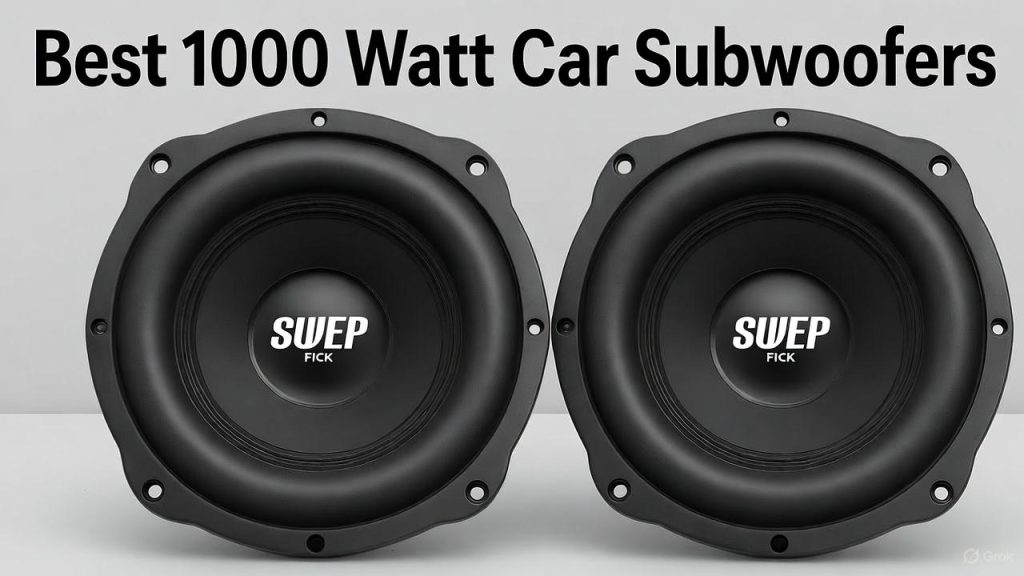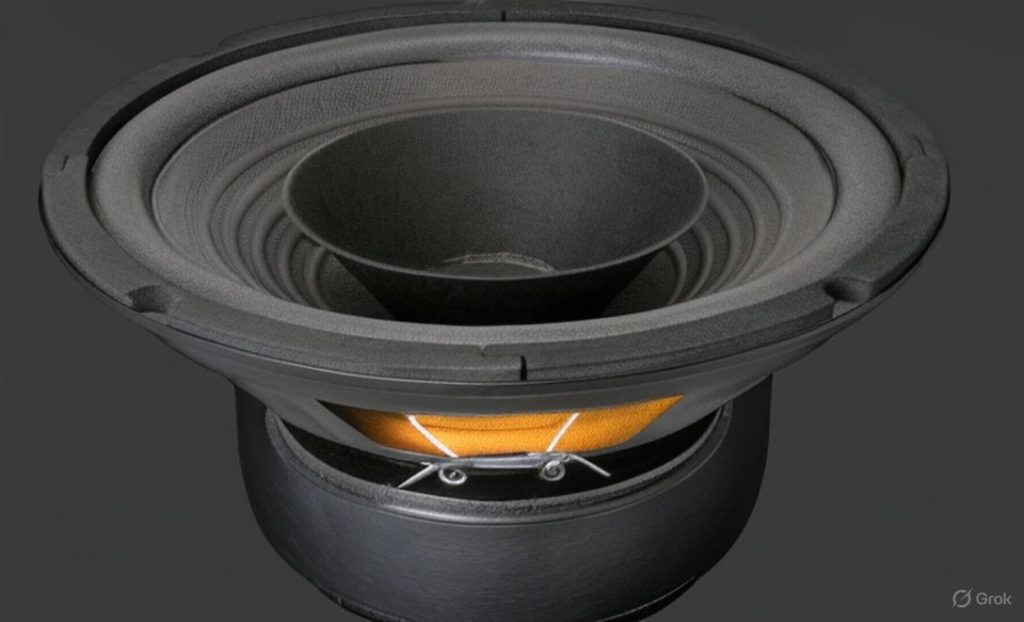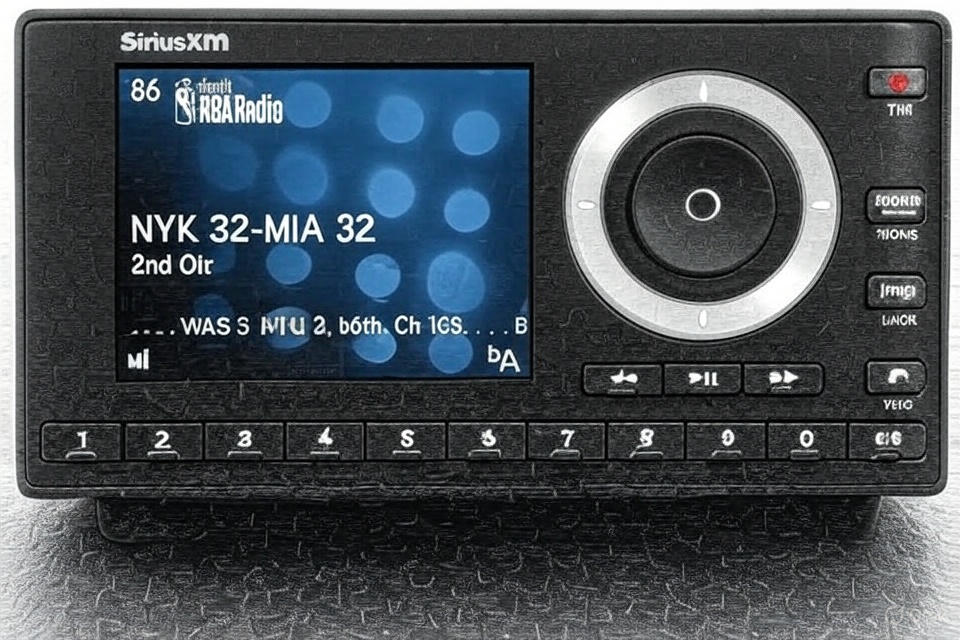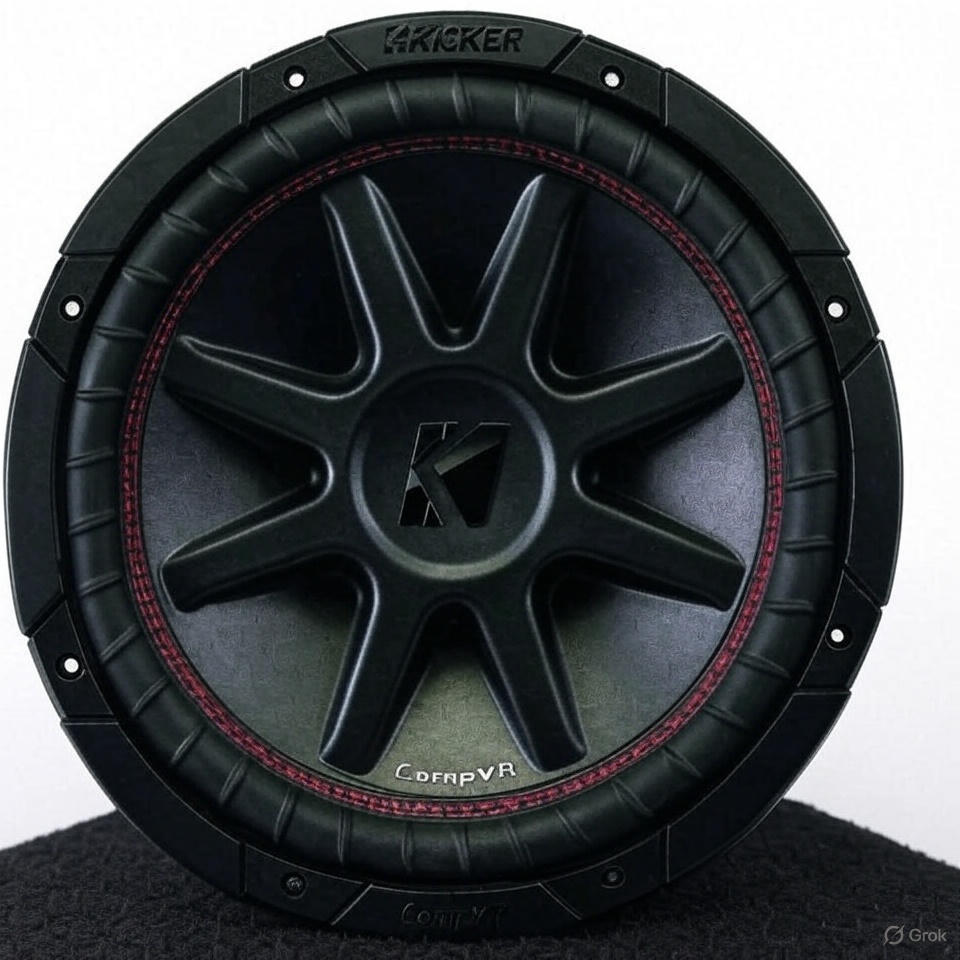When you’re ready to upgrade your car audio system, finding the right subwoofer makes all the difference. The 1000-watt power class represents a sweet spot for many automotive bass enthusiasts. This power range delivers impressive output without requiring massive amplifier investments or extensive electrical system upgrades. These speakers bring deep, chest-thumping bass to your daily commute while remaining practical for most vehicles.
The market offers various designs within this power category. You’ll find compact under-seat models perfect for trucks and sedans with limited cargo space. Shallow-mount designs allow installation in factory locations where traditional deep subwoofers won’t fit. Each option brings unique advantages depending on your vehicle type and listening preferences.
This guide examines five outstanding options in the 1000-watt category. We’ll explore their construction quality, sound characteristics, installation requirements, and real-world performance. By the end, you’ll understand which subwoofer best matches your needs and budget.
Understanding 1000 Watt Subwoofer Specifications
Power ratings can confuse newcomers to car audio. Manufacturers list both RMS (continuous) power and peak (maximum) power ratings. The 1000-watt specification typically refers to peak power – the absolute maximum the subwoofer handles for brief moments. Most drivers in this class handle 400-600 watts RMS, which represents their realistic, sustainable power capability.
Voice coil configuration significantly impacts how you wire your system. Dual voice coil designs offer more flexibility, allowing you to wire the subwoofer to different impedance loads. This flexibility helps match the speaker to your amplifier’s output capabilities. Single voice coil models are simpler but provide fewer wiring options.
Mounting depth determines where you can install the driver. Traditional subwoofers require 6-8 inches of depth behind the mounting surface. Shallow-mount designs reduce this requirement to 3-4 inches, opening up installation possibilities in space-constrained vehicles. Under-seat powered subwoofers take this even further, combining the driver and amplifier in packages as slim as 3 inches.
Sensitivity ratings indicate how efficiently the subwoofer converts power into sound. Higher sensitivity numbers mean the speaker produces more volume from the same power input. Most car subwoofers in this power range measure between 82-85 dB sensitivity. This efficiency level works well with affordable amplifiers while delivering satisfying bass output.
Product Reviews: Top 1000 Watt Car Subwoofers
1. 1000w Slim Under Seat Subwoofers with Amp and Ambient Light
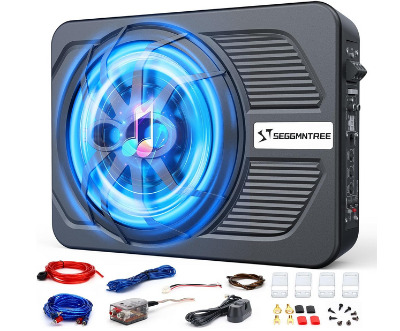
This all-in-one solution combines a 10-inch driver with a built-in amplifier in a remarkably slim package. The unit measures just 3.2 inches in height, fitting beneath most vehicle seats without sacrificing legroom. The integrated design eliminates the need for separate amplifier mounting and reduces installation complexity.
The powered subwoofer includes both high-level and low-level inputs. High-level inputs accept speaker wires from your factory radio, making installation possible without an aftermarket head unit. Low-level RCA inputs work with aftermarket stereos or signal processors. This flexibility accommodates various system configurations.
Ambient lighting adds a visual element to match the audio upgrade. Blue LED accents illuminate the subwoofer enclosure, creating atmosphere during evening listening sessions. The lighting won’t distract drivers but adds personality to your interior.
The complete wire kit simplifies installation further. Quality power cables, remote turn-on wire, and grounding accessories come included. This package approach saves time hunting down individual components and ensures proper gauge wiring for safe operation.
Product Specifications:
- Driver Size: 10 inches
- Peak Power: 1000 watts
- Mounting Height: 3.2 inches
- Input Types: High/low level
- Included: Wiring kit, LED lighting
Pros:
- Extremely space-efficient design fits under seats
- Built-in amplifier eliminates separate amp installation
- Complete wiring kit included for easy setup
- High and low level inputs for versatile compatibility
- Attractive LED ambient lighting enhances interior
- Minimal installation time required
Cons:
- Lower bass extension compared to larger enclosures
- Built-in amplifier limits future upgrade flexibility
- Aluminum housing conducts heat in extended use
- LED lights may not appeal to all users
- Limited cone excursion in shallow design
Best For: Truck owners, sedan drivers with limited trunk space, anyone seeking quick installation without sacrificing rear seat legroom or cargo area. Ideal for daily drivers who want improved bass without major modifications.
2. Skar Audio VS-10 D2 10″ 1000W Max Power Dual 2 Ohm Shallow Mount Car Subwoofer
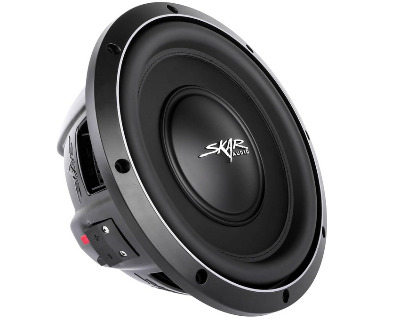
Skar Audio engineered the VS series specifically for installations where mounting depth creates challenges. This 10-inch driver delivers serious output while requiring minimal behind-panel clearance. The VS-10 handles 500 watts RMS continuously, with 1000-watt peak capability during demanding passages.
The high-temperature voice coil measures 2.4 inches in diameter with four copper layers. This robust construction dissipates heat effectively during extended listening sessions. Voice coil temperature directly affects longevity, so Skar’s attention to thermal management pays dividends in reliability.
Dual 2-ohm voice coils provide wiring flexibility for matching various amplifier impedances. You can wire the coils in series for a 4-ohm load or parallel for 1-ohm operation. Most amplifiers deliver maximum power at 2-ohm loads, which this configuration achieves easily.
The shallow mounting depth measures just 3.625 inches. This compact profile fits behind rear seats, in custom door panels, or other locations where traditional subwoofers won’t fit. The stamped steel basket provides structural rigidity while keeping weight manageable.
Product Specifications:
- Driver Size: 10 inches
- RMS Power: 500 watts
- Peak Power: 1000 watts
- Mounting Depth: 3.625 inches
- Voice Coil: 2.4″ dual 2-ohm
- Frequency Response: 30-250 Hz
- Sensitivity: 83 dB
Pros:
- Shallow mounting depth opens installation possibilities
- Quality voice coil construction ensures reliability
- Dual voice coils offer wiring flexibility
- Competitive pricing for performance level
- Skar Audio’s reputation for value
- Handles rated power without distortion
Cons:
- Requires proper enclosure design for optimal performance
- Stamped basket less rigid than cast aluminum
- Lower sensitivity than some competitors
- Needs adequate amplifier power to shine
- Foam surround may deteriorate faster than rubber
Best For: Enthusiasts building custom installations in space-limited vehicles. Works excellently behind rear seats in extended cab trucks, in slim enclosures, or anywhere traditional depth subwoofers won’t fit. Suits those who understand enclosure requirements.
3. CT Sounds Hydro 10″ Dual 2-Ohm 1000-Watt Shallow Mount Car Subwoofer
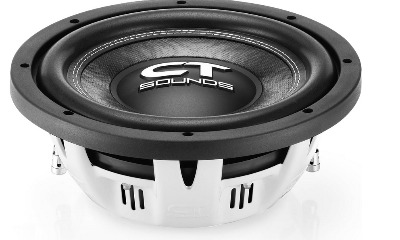
CT Sounds invested two years developing their Hydro series shallow-mount subwoofers. This engineering focus shows in the driver’s performance across both sealed and ported enclosures. Many shallow subs work well in only one enclosure type, but the Hydro’s balanced parameters excel in either configuration.
The Efficiency Bandwidth Product (EBP) determines which enclosure types suit a particular driver. CT Sounds targeted an EBP around 70, allowing the Hydro to work beautifully in sealed boxes for tight, controlled bass or ported designs for increased output. This versatility benefits installers working with various space constraints.
The 2.4-inch voice coil uses four layers of high-temperature copper wire. A 70-ounce magnet provides strong motor force for controlled cone movement. The custom-tooled cone maximizes excursion capability within the shallow form factor, extracting more output than typical thin-profile designs.
At 500 watts RMS and 1000 watts peak, the Hydro matches the power handling of the Skar VS series. The mounting depth measures 3.9 inches – slightly deeper than some competitors but still qualifying as truly shallow. This extra depth contributes to the driver’s impressive excursion capability.
Product Specifications:
- Driver Size: 10 inches
- RMS Power: 500 watts
- Peak Power: 1000 watts
- Mounting Depth: 3.9 inches
- Voice Coil: 2.4″ dual 2-ohm
- Frequency Response: 32-200 Hz
- Motor: 70-ounce magnet
Pros:
- Performs excellently in both sealed and ported boxes
- Two years of research and development shows in quality
- Custom cone design maximizes excursion
- Strong magnet motor provides control
- Good low-frequency extension for shallow design
- CT Sounds reputation for engineering
Cons:
- Slightly deeper than some shallow competitors
- Higher price point than entry-level options
- Requires proper amplifier matching
- Heavier weight due to larger motor
- May need custom fabrication for some installations
Best For: Serious enthusiasts who understand enclosure design principles. Perfect for custom installations where you can optimize box volume and tuning. Suits those wanting the flexibility to use sealed or ported configurations depending on musical preferences.
4. 10″ 1000W Slim Under Seat Powered Car Subwoofer with Blue LED Light
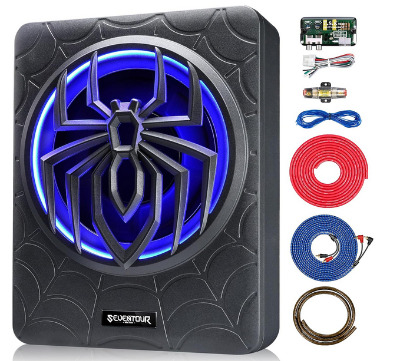
This powered subwoofer package delivers complete bass reinforcement in a single, slim enclosure. Like our first entry, this unit combines driver and amplifier in a space-saving design. The 10-inch speaker mounts in an optimized enclosure with integrated amplification, eliminating external amplifier requirements.
The built-in amplifier features adjustable controls for fine-tuning bass response. Low-pass crossover adjustment determines which frequencies the subwoofer reproduces. Bass boost control adds emphasis when listening to music with less low-frequency content. Gain adjustment matches the subwoofer’s output to your main speakers’ level.
Blue LED illumination provides visual appeal during evening driving. The lighting integrates cleanly into the enclosure design without appearing aftermarket or cheap. Some users appreciate this aesthetic touch, while others prefer more subtle equipment.
The complete mounting wire kit includes power cables, grounding wire, and necessary fuse holder. Proper gauge wiring ensures safe operation and maximum power delivery. Many budget systems fail due to inadequate wiring rather than component quality, so including proper cables adds value.
Product Specifications:
- Driver Size: 10 inches
- Peak Power: 1000 watts
- Amplifier: Built-in Class D
- Inputs: High and low level
- Controls: Gain, bass boost, crossover
- Mounting: Under-seat design
- Included: Complete wiring kit
Pros:
- Integrated amplifier simplifies installation process
- Adjustable controls optimize sound for preferences
- Compact footprint preserves cargo space
- High and low level inputs for flexibility
- Complete wire kit includes everything needed
- Blue LED lighting adds visual appeal
Cons:
- Sealed enclosure limits low-frequency extension
- Built-in amp restricts future upgrades
- Amplifier generates heat during operation
- Less customizable than component systems
- May require periodic fuse replacement
Best For: Daily drivers seeking straightforward bass improvement without complex installations. Excellent for vehicles where preserving cargo space matters. Suits buyers who value convenience and want everything necessary in one package. Works great for casual listeners focused on improved sound rather than competition-level output.
5. CT Sounds Hydro 10″ Dual 4-Ohm 1000-Watt Shallow Mount Car Subwoofer
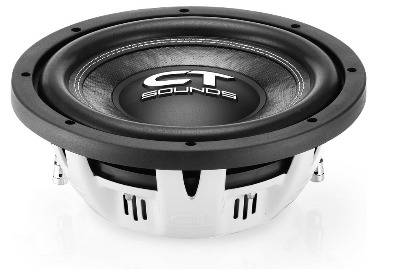
This variant of the CT Sounds Hydro offers identical performance characteristics with different voice coil impedance. The dual 4-ohm configuration provides alternative wiring options compared to the dual 2-ohm model. Some amplifiers perform optimally at specific impedance loads, so having both options allows precise system matching.
Wired in series, the dual 4-ohm coils present an 8-ohm load to your amplifier. Parallel wiring creates a 2-ohm load. Many entry-level amplifiers don’t support 1-ohm operation, making the dual 4-ohm configuration more compatible with budget-friendly amps. This flexibility benefits system planners working with existing equipment.
The engineering excellence that defines the Hydro series carries over completely. You get the same custom-tooled cone, 70-ounce motor, and balanced parameters that work in sealed or ported enclosures. The 500-watt RMS power handling and 1000-watt peak capability remain identical.
Installation requirements mirror the dual 2-ohm version. The 3.9-inch mounting depth fits the same locations, and the overall dimensions match exactly. Your choice between impedance variants depends purely on amplifier specifications and system design goals.
Product Specifications:
- Driver Size: 10 inches
- RMS Power: 500 watts
- Peak Power: 1000 watts
- Mounting Depth: 3.9 inches
- Voice Coil: 2.4″ dual 4-ohm
- Frequency Response: 32-200 Hz
- Motor: 70-ounce magnet
Pros:
- Dual 4-ohm coils suit more amplifiers
- Excellent sealed and ported enclosure performance
- Robust construction ensures longevity
- Balanced parameters from extensive development
- Compatible with entry-level amplifiers
- Same quality as dual 2-ohm variant
Cons:
- Cannot achieve 1-ohm loads for maximum power
- Higher price than some competitors
- Requires proper enclosure volume
- Mounting depth slightly more than minimum shallow
- May be overkill for casual listeners
Best For: System builders matching components carefully for optimal performance. Perfect when your amplifier delivers peak power at 2-ohm loads. Suits enthusiasts who want maximum flexibility in enclosure design without stepping up to full-depth subwoofers. Ideal for balanced systems prioritizing sound quality over absolute maximum output.
Installation Considerations for 1000 Watt Subwoofers
Installing a 1000-watt subwoofer requires attention to several critical factors. Proper execution ensures your system performs reliably while avoiding potential problems. These considerations apply whether you’re tackling the job yourself or supervising professional installation.
Amplifier Selection and Matching
Your amplifier should deliver power matching the subwoofer’s RMS rating. Underpowering causes more problems than slightly overpowering. When you turn up an inadequate amplifier, it clips the signal – creating distortion that damages speakers. A properly sized amplifier running at moderate levels produces clean, undistorted bass.
Impedance matching matters significantly. Calculate the final impedance your wiring configuration creates, then verify your amplifier supports that load. Operating amplifiers outside their specified impedance range risks overheating and failure. Most budget amplifiers work best at 2-ohm loads, where they deliver peak power without excessive strain.
Class D amplifiers dominate modern subwoofer applications. Their high efficiency generates less heat and draws less current from your electrical system. Older Class AB designs waste energy as heat, requiring larger power cables and potentially stressing your alternator. Class D technology makes 500-watt systems practical in most vehicles without electrical upgrades.
Enclosure Requirements
Shallow-mount subwoofers still require proper enclosure volume despite their compact depth. Physics doesn’t change because a speaker is thin. The enclosure’s internal volume affects how the driver responds across the frequency range. Too small creates boomy, one-note bass. Too large produces weak, undefined low frequencies.
Sealed enclosures offer the simplest route to good sound. They’re easier to build, require less volume, and produce tight, accurate bass. Ported enclosures deliver more output but demand precise tuning. Port length and diameter calculations require more effort, and mistakes create unpleasant resonances. Start with sealed designs unless you’re confident in your building skills.
Construction quality dramatically affects results. Use 3/4-inch MDF for rigidity. Avoid particle board, which lacks strength and durability. Seal all joints with silicone caulk to prevent air leaks. Line interior surfaces with polyfill or acoustic foam to control standing waves. These details separate mediocre systems from impressive ones.
Wiring and Power Requirements
Use proper gauge wire for your power runs. Eight-gauge wire handles most 500-watt amplifiers adequately. Four-gauge provides insurance for extended listening sessions or marginal electrical systems. Never use wire thinner than the amplifier manufacturer recommends. Inadequate wire causes voltage drops, reducing power delivery and potentially creating fire hazards.
Fuse placement protects your vehicle and system. Install the main fuse within 18 inches of your battery connection. This fuse should match the wire gauge and amplifier requirements. Many installers skimp here, but proper fusing prevents catastrophic wire fires if something shorts. Don’t overlook this critical safety component.
Ground connections cause more system problems than any other factor. Use short ground wires – under 18 inches when possible. Connect to bare metal, not painted surfaces. Sand the connection point to bright metal, ensuring solid electrical contact. Test ground resistance with a multimeter. Readings above 0.5 ohms indicate problems requiring correction.
Space Planning and Location
Under-seat locations work wonderfully for powered subwoofers. Measure carefully before purchasing. Verify seat travel doesn’t create clearance issues. Account for uneven floor surfaces that might reduce usable height. Some vehicles have fuel tanks or exhaust components limiting mounting options.
Trunk installations offer more flexibility for component subwoofers. Consider access to your spare tire and jack. Plan enclosure placement so you can still load cargo easily. Side-mounted enclosures preserve central trunk space better than rear-facing designs in many vehicles.
Custom fabrication opens additional possibilities. Door-mounted subwoofers, rear deck installations, or under-rear-seat placements work with shallow designs. These locations require more skill but maximize space efficiency. Research your specific vehicle for installation ideas from other enthusiasts.
Shallow Mount vs. Regular Subwoofers: Making the Right Choice
Understanding the practical differences between shallow-mount and full-depth subwoofers helps guide your decision. Both designs produce quality bass, but they suit different applications and priorities. Your vehicle type and installation goals determine which approach works best.
Performance Characteristics
Shallow-mount subwoofers sacrifice some excursion capability for reduced depth. Less cone travel means less air movement, which affects maximum output potential. However, modern shallow designs minimize this compromise through improved materials and motor structures. The gap in performance continues narrowing as manufacturers refine these speakers.
Full-depth subwoofers typically achieve greater excursion, moving more air per stroke. This advantage matters most at extreme volume levels or when reproducing very low frequencies. For most listening scenarios, quality shallow-mount drivers perform indistinguishably from full-depth models. The difference emerges mainly during competition-level playback or when pushing systems to their limits.
Frequency response remains similar between designs when properly enclosured. Shallow speakers reach down to 30-35 Hz in appropriate boxes – low enough for any music. The myth that shallow subwoofers “can’t play low” stems from installations in undersized enclosures. Respect the driver’s volume requirements and both designs deliver satisfying low-frequency extension.
Enclosure Flexibility
Here’s the surprising truth: shallow-mount subwoofers don’t necessarily require smaller enclosures. They need less depth behind the mounting surface, but internal volume requirements remain similar to full-depth models. The advantage is fitting in locations where depth is limited, not building tiny boxes.
Full-depth subwoofers demand more clearance behind the mounting surface. This requirement restricts placement options in many vehicles. You’re typically limited to trunk-mounted enclosures or custom installations with dedicated space allocation. The additional depth does allow for more aggressive cone excursion capability.
Both designs work in sealed or ported enclosures. The enclosure type affects sound character more than the driver’s depth. Sealed boxes produce tight, controlled bass ideal for rock, jazz, and accurate reproduction. Ported designs emphasize output and efficiency, suiting hip-hop, electronic music, and those seeking maximum volume.
Installation Practicality
Shallow-mount subwoofers open installation locations unavailable to full-depth models. Behind rear seats in extended cab trucks, in custom rear deck installations, or in slim wall-mounted enclosures – these applications leverage reduced depth requirements. The flexibility justifies any minor performance compromises for many enthusiasts.
Full-depth installations usually center around trunk-mounted enclosures or dedicated subwoofer boxes. This approach works perfectly in vehicles with adequate cargo space. However, it consumes valuable carrying capacity and may require custom fabrication for clean, integrated appearances.
Powered under-seat subwoofers represent the ultimate in installation simplicity. These packages slide under seats with minimal fabrication. Basic wiring completes the installation in under an hour for most vehicles. The convenience appeals strongly to daily drivers prioritizing practicality over absolute maximum performance.
Sound Quality vs. Output: Setting Realistic Expectations
A 1000-watt (peak) subwoofer delivers substantial bass reinforcement for most listeners. Understanding what this power level provides helps set appropriate expectations. You won’t shake buildings from blocks away, but you’ll certainly feel the music’s foundation properly.
Real-World Power Levels
That 1000-watt peak rating translates to roughly 400-500 watts continuous power handling. This represents the realistic power level you’ll feed these drivers during normal listening. Peak ratings account for brief transients in music – drum hits, bass drops, or explosive movie effects. These momentary demands exceed continuous levels significantly.
Five hundred watts of clean, undistorted bass power creates impressive output in vehicle cabins. Cars are small, acoustically efficient environments. The confined space allows relatively modest power levels to generate substantial sound pressure. You don’t need kilowatts of power unless you’re competing or seeking truly deafening volume.
Amplifier efficiency affects real-world results significantly. A quality 500-watt amplifier produces noticeably more output than a budget model claiming similar specifications. Clean power matters more than maximum ratings. Invest in reputable amplifiers that deliver rated power without distortion for best results.
Musical Genre Considerations
Different music styles place varying demands on subwoofers. Electronic music, hip-hop, and modern pop feature synthesized bass with substantial low-frequency content. These genres benefit most from subwoofer reinforcement. The improvement in sound quality is dramatic and immediately noticeable.
Rock, jazz, and classical music include less synthesized bass content. Subwoofers still add valuable foundation, filling out kick drums and upright bass. The improvement is more subtle but contributes to realistic reproduction. These genres don’t require extreme output levels for satisfying results.
Movies and gaming benefit significantly from subwoofer systems. Sound effects extend well below what door speakers reproduce. Explosions, thunder, engines, and environmental ambience all contain substantial low-frequency content. The immersive experience improves dramatically with proper bass reinforcement.
Volume Level Realities
A well-configured 500-watt system plays louder than most enthusiasts want during daily driving. Conversation becomes difficult above moderate levels. Extended listening at extreme volume causes fatigue and hearing damage. Most people use a fraction of their system’s capability most of the time.
The goal is clean bass at your preferred listening level, not absolute maximum volume. A quality 1000-watt system playing at 70% capacity sounds better than an inadequate system running at maximum. Headroom prevents distortion and extends equipment life. Buy enough power to reach your desired levels comfortably, then enjoy the music.
System balance matters more than raw subwoofer output. Your bass should complement the main speakers, not overwhelm them. The subwoofer fills in frequencies below what door speakers reproduce effectively. When properly integrated, you shouldn’t distinctly hear the subwoofer location – the system should sound cohesive and natural.
Maintenance and Long-Term Care
Quality subwoofers provide years of reliable service with minimal maintenance. A few simple practices protect your investment and ensure continued performance. These habits apply regardless of which product you’ve chosen.
Preventing Thermal Damage
Voice coils fail primarily from excessive heat buildup. Extended operation at maximum volume generates more heat than the motor structure can dissipate. The voice coil overheats, melting the adhesive bonding the wire layers. Once separated, the coil deforms and drags against the magnet gap, causing permanent damage.
Allow cooling periods during extended listening sessions. Running your system hard for hours without breaks tests thermal limits. Lower the volume periodically, giving the voice coil time to cool. This simple practice dramatically extends driver longevity. You’ll also preserve your hearing, which benefits from periodic rest.
Clipped amplifier signals cause more heat damage than clean signals at the same power level. Distorted waveforms contain high-frequency energy that heats voice coils rapidly. This explains why underpowered systems often fail sooner than properly matched ones. The amplifier distorts trying to deliver more power than it can cleanly produce.
Protecting Against Physical Damage
Keep loose objects away from speaker cones. Tools, cargo, or other items bouncing against the cone cause tears or deformation. Many trunk installations suffer damage from poorly secured cargo. Build protective grilles if your installation exposes the cone to potential contact.
Moisture represents a significant threat to subwoofers. Water damages voice coils, cones, and surrounds. Avoid installations in areas prone to leaks. Trucks with tonneau covers or unsealed trunk spaces need particular attention. Consider marine-grade subwoofers for wet environments or open-air vehicles.
Electrical surges occasionally damage subwoofers, though this is less common than thermal or physical damage. Protect your system by installing properly rated fuses. Disconnect your battery before making wiring changes. These precautions prevent accidental shorts that can destroy voice coils instantly.
Periodic Inspection
Check your subwoofer periodically for signs of problems. Look for cone damage, torn surrounds, or voice coil rubbing. Listen for unusual sounds indicating mechanical issues. Catching problems early often allows repair before catastrophic failure.
Verify all connections remain tight and corrosion-free. Terminals loosen over time from vibration. Corroded connections increase resistance, reducing power delivery. Clean terminals annually and apply dielectric grease to prevent oxidation.
Monitor amplifier operation for signs of stress. Excessive heat, blown fuses, or distortion indicate problems requiring attention. Address issues promptly rather than operating faulty equipment. Most amplifier problems worsen rapidly when ignored.
Conclusion: Choosing Your Perfect 1000 Watt Subwoofer
The five subwoofers reviewed here represent different approaches to the 1000-watt category. Your ideal choice depends on your specific needs, vehicle type, and listening preferences. Let’s summarize the key points to guide your decision.
For maximum installation simplicity and minimal space consumption, the powered under-seat options excel. These packages combine everything necessary in compact, integrated designs. They work beautifully for daily drivers who want better bass without extensive modifications. The convenience justifies slightly compromised performance for many buyers.
The Skar Audio VS-10 D2 offers outstanding value for enthusiasts comfortable building proper enclosures. This shallow-mount driver delivers solid performance at competitive pricing. The dual 2-ohm configuration suits most amplifiers well. Budget-conscious buyers seeking component flexibility should consider this option seriously.
CT Sounds Hydro models represent engineered excellence in the shallow-mount category. The development effort shows in these drivers’ versatility across enclosure types. They cost more than basic options but deliver refined performance justifying the investment. Serious enthusiasts building quality systems benefit from the Hydro’s capabilities.
Voice coil impedance choice between the Hydro variants depends entirely on your amplifier specifications. Neither is inherently better – match whichever impedance allows optimal amplifier operation. Review your amplifier’s specifications and choose accordingly.
Remember that quality installation matters as much as component selection. Proper enclosure design, adequate amplifier power, and correct wiring execution determine real-world results. The best subwoofer sounds mediocre when poorly installed. Conversely, mid-range drivers excel when everything is done correctly.
Start your installation planning by measuring available space carefully. Determine mounting depth restrictions and enclosure volume possibilities. These physical constraints narrow your options significantly. Then consider your sonic goals – do you want tight, accurate bass or maximum output? Match your component selection to these priorities.
Budget allocation should balance components sensibly. Don’t pair a premium subwoofer with an inadequate amplifier. Likewise, avoid expensive amplification for entry-level speakers. Balanced systems where components match in quality deliver better results than uneven combinations.
The 1000-watt power class offers excellent performance for most applications. These subwoofers provide substantial bass reinforcement without requiring extreme electrical system modifications. You’ll achieve satisfying results in typical vehicles with standard alternators and batteries. This makes the category particularly practical for daily-driver installations.
Your musical tastes influence which specifications matter most. Bass-heavy electronic music benefits from maximum output capability. Jazz and acoustic music prioritize accuracy and control over volume. Rock sits somewhere between, needing both impact and definition. Consider what you actually listen to, not just what sounds impressive.
Take time researching your specific vehicle’s installation challenges. Online forums often contain valuable information from others who’ve installed audio systems in your model. Learn from their successes and mistakes. This research saves time and prevents costly errors.
Finally, don’t overlook the importance of proper system tuning after installation. Even perfect components sound disappointing when poorly adjusted. Set your amplifier gain correctly using a test tone and multimeter. Adjust crossover points to blend seamlessly with your main speakers. Fine-tune bass boost and equalizer settings for your preferences. These adjustments transform good systems into great ones.
All five subwoofers reviewed here will serve you well within their intended applications. They represent quality products from reputable manufacturers. Your personal priorities and vehicle constraints determine which suits your needs best. Consider the information presented, assess your specific situation, and choose confidently knowing you understand the options thoroughly.
Remember that upgrading your car audio system should enhance your driving enjoyment. The process can be fun and rewarding when approached systematically. Take your time, do things properly, and you’ll enjoy years of improved sound quality on every drive.
